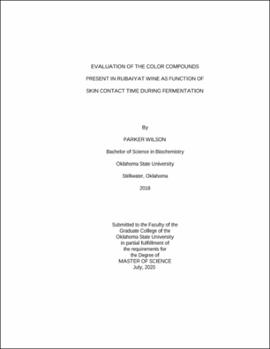| dc.contributor.advisor | McGlynn, William | |
| dc.contributor.author | Wilson, Parker | |
| dc.date.accessioned | 2021-02-22T22:41:26Z | |
| dc.date.available | 2021-02-22T22:41:26Z | |
| dc.date.issued | 2020-07 | |
| dc.identifier.uri | https://hdl.handle.net/11244/328677 | |
| dc.description.abstract | This research evaluated a hybrid grape originating from Oklahoma State University to determine the physical and chemical characteristics of the wine it produced and its viability as a coloring agent in commercial winemaking. The grape variety is known as Rubaiyat and it was first introduced in 1975 at Oklahoma State University by Dr. Herman Hinrichs. Rubaiyat has been proposed as a teinturier (coloring wine) for commercial winemaking due to the grape's deep purple/blue skin and the presense of pigments in the grape flesh. However, prior to this research, there have not been any data recorded to determine the suitability of the Rubaiyat grape for this particular purpose. The criteria evaluated in this project included standard assays of wine characteristics, the total phenolic content, and colorimetric analysis with a focus on the effect of skin contact time on extraction of anthocyanins and other pigments. To do this, standard assays of quality such as pH, titratable acidity, and total alcohol content were used to determine the general characteristics and quality of the Rubaiyat wine produced. The winemaking process used in this experiment was kept simple to focus on the biochemical interactions between the grape and the wine. The process included destemming/crushing, adding yeast, and then taking samples daily until the wine was pressed. Samples were then taken weekly and the wine was also racked (decanted) weekly. Color analyses showed that pigment extraction, was essentially complete after two days of maceration. Also, spectrophotometric testing demonstrated that red pigments have the highest rate of extraction. The wine produced from the Rubaiyat grapes did not have the concentration of pigments that would make it a useful teinturier grape. Beyond this, the Rubaiyat wines produced in this study was typical in terms of basic physical and chemical characteristics when compared to the more popular European grape varieties. | |
| dc.format | application/pdf | |
| dc.language | en_US | |
| dc.rights | Copyright is held by the author who has granted the Oklahoma State University Library the non-exclusive right to share this material in its institutional repository. Contact Digital Library Services at lib-dls@okstate.edu or 405-744-9161 for the permission policy on the use, reproduction or distribution of this material. | |
| dc.title | Evaluation of the color compounds present in Rubaiyat wine as function of skin contact time during fermentation | |
| dc.contributor.committeeMember | Ramanathan, Ranjith | |
| dc.contributor.committeeMember | Bowser, Tim | |
| osu.filename | Wilson_okstate_0664M_16836.pdf | |
| osu.accesstype | Open Access | |
| dc.type.genre | Thesis | |
| dc.type.material | Text | |
| thesis.degree.discipline | Food Science | |
| thesis.degree.grantor | Oklahoma State University | |
